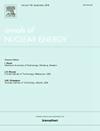Preliminary criticality analysis of a partially damaged reactor core under different scenarios
IF 1.9
3区 工程技术
Q1 NUCLEAR SCIENCE & TECHNOLOGY
引用次数: 0
Abstract
This study examined the criticality characteristics of a partially damaged reactor model, in which fuels located at the core center melt into fuel debris of varying shapes, while fuels situated at the core edge remain intact. The investigation was conducted using the Serpent code with the JENDL-5 library. The results indicate that when the volume of fuel debris is constant, the shape of the fuel debris does not cause significant alterations in the variation of the keff of the system. In contrast, for the scenario of the variable fuel-debris volume, the keff variation law can be divided into two groups for the reference case with a system temperature of 300 K and no boron in the water. The first group comprises fuel debris with cuboid and cylindrical shapes, while the second group includes spherical, conical, and truncated conical shapes.
不同情况下部分受损反应堆堆芯的初步临界分析
本研究考察了部分损坏反应堆模型的临界特性,其中位于堆芯中心的燃料熔化成不同形状的燃料碎片,而位于堆芯边缘的燃料保持完整。调查是使用带有JENDL-5库的Serpent代码进行的。结果表明,在燃料碎屑体积一定的情况下,燃料碎屑的形状对系统转速的变化影响不大。相比之下,对于变燃料碎片体积的情况,在体系温度为300 K、水中不含硼的参考情况下,keff变化规律可以分为两组。第一组包括长方体和圆柱形的燃料碎片,第二组包括球形、圆锥形和截圆锥形。
本文章由计算机程序翻译,如有差异,请以英文原文为准。
求助全文
约1分钟内获得全文
求助全文
来源期刊

Annals of Nuclear Energy
工程技术-核科学技术
CiteScore
4.30
自引率
21.10%
发文量
632
审稿时长
7.3 months
期刊介绍:
Annals of Nuclear Energy provides an international medium for the communication of original research, ideas and developments in all areas of the field of nuclear energy science and technology. Its scope embraces nuclear fuel reserves, fuel cycles and cost, materials, processing, system and component technology (fission only), design and optimization, direct conversion of nuclear energy sources, environmental control, reactor physics, heat transfer and fluid dynamics, structural analysis, fuel management, future developments, nuclear fuel and safety, nuclear aerosol, neutron physics, computer technology (both software and hardware), risk assessment, radioactive waste disposal and reactor thermal hydraulics. Papers submitted to Annals need to demonstrate a clear link to nuclear power generation/nuclear engineering. Papers which deal with pure nuclear physics, pure health physics, imaging, or attenuation and shielding properties of concretes and various geological materials are not within the scope of the journal. Also, papers that deal with policy or economics are not within the scope of the journal.
 求助内容:
求助内容: 应助结果提醒方式:
应助结果提醒方式:


